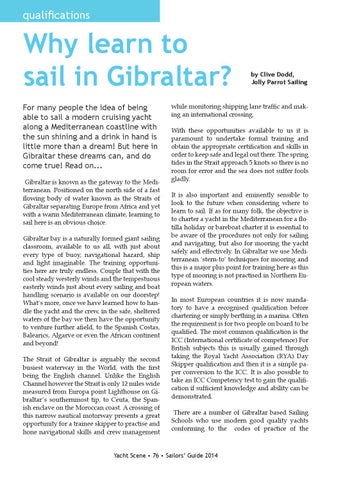qualifications
Why learn to sail in Gibraltar? For many people the idea of being able to sail a modern cruising yacht along a Mediterranean coastline with the sun shining and a drink in hand is little more than a dream! But here in Gibraltar these dreams can, and do come true! Read on... Gibraltar is known as the gateway to the Mediterranean. Positioned on the north side of a fast flowing body of water known as the Straits of Gibraltar separating Europe from Africa and yet with a warm Mediterranean climate, learning to sail here is an obvious choice. Gibraltar bay is a naturally formed giant sailing classroom, available to us all, with just about every type of buoy, navigational hazard, ship and light imaginable. The training opportunities here are truly endless. Couple that with the cool steady westerly winds and the tempestuous easterly winds just about every sailing and boat handling scenario is available on our doorstep! What’s more, once we have learned how to handle the yacht and the crew, in the safe, sheltered waters of the bay we then have the opportunity to venture further afield, to the Spanish Costas, Balearics, Algarve or even the African continent and beyond! The Strait of Gibraltar is arguably the second busiest waterway in the World, with the first being the English channel. Unlike the English Channel however the Strait is only 12 miles wide measured from Europa point Lighthouse on Gibraltar’s southernmost tip, to Ceuta, the Spanish enclave on the Moroccan coast. A crossing of this narrow nautical motorway presents a great opportunity for a trainee skipper to practise and hone navigational skills and crew management
by Clive Dodd, Jolly Parrot Sailing
while monitoring shipping lane traffic and making an international crossing. With these opportunities available to us it is paramount to undertake formal training and obtain the appropriate certification and skills in order to keep safe and legal out there. The spring tides in the Strait approach 5 knots so there is no room for error and the sea does not suffer fools gladly. It is also important and eminently sensible to look to the future when considering where to learn to sail. If as for many folk, the objective is to charter a yacht in the Mediterranean for a flotilla holiday or bareboat charter it is essential to be aware of the procedures not only for sailing and navigating, but also for mooring the yacht safely and effectively. In Gibraltar we use Mediterranean ‘stern-to’ techniques for mooring and this is a major plus point for training here as this type of mooring is not practised in Northern European waters. In most European countries it is now mandatory to have a recognised qualification before chartering or simply berthing in a marina. Often the requirement is for two people on board to be qualified. The most common qualification is the ICC (International certificate of competence) For British subjects this is usually gained through taking the Royal Yacht Association (RYA) Day Skipper qualification and then it is a simple paper conversion to the ICC. It is also possible to take an ICC Competency test to gain the qualification if sufficient knowledge and ability can be demonstrated. There are a number of Gibraltar based Sailing Schools who use modern good quality yachts conforming to the codes of practice of the
Yacht Scene • 76 • Sailors’ Guide 2014
